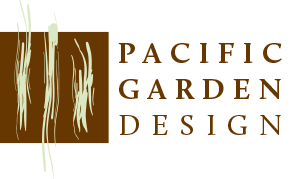Landscape edging provides a crisp delineation between lawn and bed areas, but it is also frequently used to contain gravel pathways and patios. There are a variety of materials that can be used for edging, and each has a distinct style and functionality. The final choice often comes down to lifestyle factors, and Pacific Garden Design has experience installing all type of edging in its landscaping projects. Here’s a quick rundown of three major edging choices that are all installed by digging a trench, anchoring the edging, and backfilling.
“Poly” Edging
The old standby that most people will be familiar with is black polyethylene (often abbreviated to “poly”) plastic edging. It’s a very cost-effective solution and is fairly easy to DIY, so it’s become the most common choice for landscape edging. Poly edging’s flexible nature makes it easy to form flowing, organic shapes across rolling terrain, and its position can be shifted if a bed is moved in the future. Once it is installed, black poly edging becomes barely noticeable, receding from view to blend with the landscape.
The major drawback for poly edging, however, is its longevity. Because it is plastic, poly edging can degrade and become brittle with months and years of UV exposure. It requires special care when mowing or line trimming around the edging so as not to damage the material, especially the hollow tube that forms the top. It’s flexibility is a drawback when edging gravel paths and patios, as it is often too weak to effectively contain the rock. And while poly edging is well-suited to flowing curves, it doesn’t lend itself to straight lines and geometric layouts.
Metal Edging
Metal edging is similar to poly edging in its installation, but it is a much more durable product. Steel edging products are available, but for the best lifespan opt for aluminum, which won’t rust like steel. Metal edging is thin enough to virtually disappear in the landscape while still providing excellent definition between planting beds and lawn.
Steel edging is certainly more expensive than plastic, though, with an additional premium for aluminum, and that extra cost can be a deciding factor in many landscaping projects. While it can be used for geometric or curvilinear shapes equally well, it is unsuitable for hilly sites, as it is not flexible in the vertical direction. Finally, metal edging’s thin profile usually means that a pass with the string trimmer to clean up the perimeter is necessary after mowing the lawn.
Composite Edging
Composite bender-board edging strikes a balance between poly and metal edging in both price and functionality. Since it is a solid piece of material, it is more resistant to damage than poly edging, although it still suffers from UV degradation. It can be used for straight runs or curves, though it is not good for hilly sites. Composite edging is thicker than metal, but is available in a variety of colors that will blend into the landscape. That extra bulk is helpful when edging gravel paths and patios, however, as composite bender-board is rigid enough to contain the heavy gravel. And like poly and metal edging, it can be moved if the landscape is altered in the future.
The next post will cover a few more edging options that are different than those listed above. If you’re considering a landscape makeover, get in touch with us at Pacific Garden Design talk about your options


